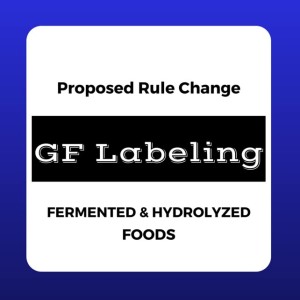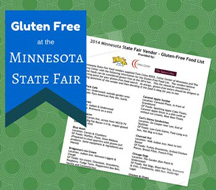Fermented, Hydrolyzed & Distilled Foods go under the Gluten Free Microscope from the FDA
November 21, 2015 by Amy Leger | G+ Amy Leger This week the US Food and Drug Administration took aim on fermented, hydrolyzed and distilled foods when it comes to gluten free labeling. This topic has been pretty vague in the finalized gluten free labeling rule since it went into effect in August of 2014.
This week the US Food and Drug Administration took aim on fermented, hydrolyzed and distilled foods when it comes to gluten free labeling. This topic has been pretty vague in the finalized gluten free labeling rule since it went into effect in August of 2014.
The problem: There is no validated, scientific test that is reliable to tell if a fermented or hydrolyzed food contains 20 ppm of gluten or more (which would render it NOT gluten free by the FDA).
This week, the FDA wrote in its proposed rule submission to The Federal Register, “Although test methods for the detection of gluten fragments in fermented and hydrolyzed foods have advanced, there is still uncertainty in interpreting the results of these test methods on a quantitative basis that equates the test results to an equivalent amount of intact gluten.”
So the FDA decided it needed to implement a rule to cover fermented and hydrolyzed foods like sauerkraut, pickles, beer, wine or hydrolyzed plant proteins (which are used as ingredients in some foods).
At its most basic, hydrolyzed, fermented and distilled foods with the gluten free label have to meet the main requirements of the gluten-free labeling rule. Beyond that, the new proposed rule digs deeper into compliance measures for manufacturers (you can read this in more detail on The Federal Register):
- Companies making fermented or hydrolyzed foods and want to label the products gluten free, must keep records that “demonstrate adequate assurance that the food is ‘gluten-free’ in compliance with the [gluten-free rule] before fermentation or hydrolysis”, the executive summary states.
- For foods with one or more fermented or hydrolyzed ingredients that will be labeled gluten free, the manufacturer will have to keep records showing that the ingredients are gluten free.
- Finally, distilled foods are also addressed. Compliance with gluten-free labeling would mean verifying the absence of the protein using testing methods that can “reliably detect the presence of protein or protein fragments in the food”.
The manufacturer also needs to take cross-contamination into consideration. If there is a risk, they need to come up with a plan to prevent it.
A comment period opened up on November 18th. You can submit your comment from now until February 16, 2016. Click here to find out how you can comment. Eventually, when the rule is enacted, companies will have one year from that date to come into compliance.
Gluten free labeling and beer has probably been the most public sticking point on the subject. Companies like Omission make gluten-removed beer. It cannot be labeled gluten free, according to the FDA, because it is made with barley malt, which contains gluten. Omission’s website explains the next part of the process, “Once the beers are ready for the fermentation tanks, we add a brewing enzyme called Brewers Clarex™ which breaks apart and detoxifies the gluten protein chains.” Since the FDA says there still is no test to confirm these claims, it has not been able to label gluten free.
The Tobacco Tax and Trade Bureau actually oversees gluten-free labeling of malt beverages. I did contact the TTB this week, and it is still evaluating the FDA’s proposal and is not commenting just yet on what it means for that market.
We will have to wait and see on how this all develops, I will offer you updates here as they become available.
Additional FDA Resources:
Q/A on Proposed Rule for GF Labeling of Fermented or Hydrolyzed Foods
Tags: celiac, FDA, fermentation, fermented, food, Food and Drug Administration, foods, free, gluten, gluten-free, hydrolyzed, proposed, rule, sensitivity, symptoms



Leave a Reply